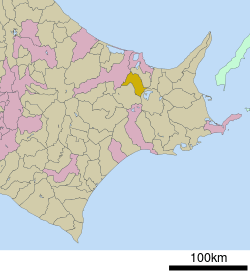Bihoro, Hokkaido
| Bihoro 美幌町 | ||
|---|---|---|
| Town | ||
| ||
 Location of Bihoro in Hokkaido (Okhotsk Subprefecture) | ||
 Bihoro Location in Japan | ||
| Coordinates: 43°49′30″N 144°6′20″E / 43.82500°N 144.10556°ECoordinates: 43°49′30″N 144°6′20″E / 43.82500°N 144.10556°E | ||
| Country | Japan | |
| Region | Hokkaido | |
| Prefecture | Hokkaido (Okhotsk Subprefecture) | |
| District | Abashiri | |
| Government | ||
| • Mayor | Tsuchiya Kōji (土谷耕治) | |
| Area | ||
| • Total | 438.36 km2 (169.25 sq mi) | |
| Population (2009) | ||
| • Total | 22,117 | |
| • Density | 50/km2 (130/sq mi) | |
| Symbols | ||
| • Tree | Taxus cuspidata | |
| • Flower | Rhododendron dauricum | |
| Time zone | Japan Standard Time (UTC+9) | |
| City Hall Address |
2 Chōme 25 Banchi, Aza Higashi 2 Jō Kita, Bihoro-chō, Abashiri-gun, Hokkaidō 092-8650 | |
| Website |
www | |
Bihoro (美幌町 Bihoro-chō) is a town located in Abashiri District, Okhotsk Subprefecture, Hokkaido, Japan. The name is derived from the Ainu word piporo, meaning "place of much water".
Largely agricultural, the town is best known for the Bihoro Pass, which affords scenic views over Lake Kussharo in the Akan National Park.
As of 2009, the town has an estimated population of 22,117 and a population density of 50 persons per km². The total area is 438.36 km².
History
- 1915 Bihoro Village founded
- 1919 Tsubetsu Village (津別村), now Tsubetsu Town, split
- 1921 Part of Tsubetsu Village incorporated
- 1923 Bihoro Village becomes Bihoro Town
- 1946 Part of Memanbetsu Village (now Memanbetsu Town) incorporated
- 1953 Bihoro song, Toru Takemitsu
External links
 Media related to Bihoro, Hokkaidō at Wikimedia Commons
Media related to Bihoro, Hokkaidō at Wikimedia Commons-
 Bihoro travel guide from Wikivoyage
Bihoro travel guide from Wikivoyage - Official website (Japanese)
- Bihoro song (Japanese)
|
This article is issued from Wikipedia - version of the Friday, November 06, 2015. The text is available under the Creative Commons Attribution/Share Alike but additional terms may apply for the media files.
